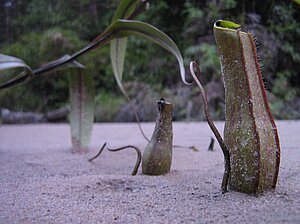Carnivorous Plants: Co-Evolution of Traps and Microbiota
Summary
Carnivorous plants are marvelous research objects and have been studied for over a century. In most cases they grow in nutrient-depleted, acidic soils with centres of diversity in the tropics. They derive nutrients usually from arthropod prey, which they catch and digest with adapted morphological capturing-structures, and likely with microbial help. Surprisingly little is however known about such associations with microorganisms. Recently we started to investigate microbial associations in this system with emphasis on the following topics:
- Assessing microbiota composition of various carnivorous plants (Unibund AZ13-43) \
- Understand the dynamics of trap microbiota in active digestion and inactive phases (Unibund AZ13-43)
- Relating trapping strategy, prey and bioregional microbial taxon pool to trap microbiota (Unibund AZ15-35)
- Identify convergent and co-evolutionary patterns with plants phylogeny and nutrient acquisition (Unibund AZ15-35)
- Genomics, transcriptomics and bioassays of carnivorous plant-associated bacteria to identify ecological functions and molecular mechanisms (funding proposal in preparation)
- Genomics, transcriptomics and bioassays to elucidate the role of microbiota in prey decomposition, triggering of secretion, acidification and nutrient uptake (funding proposal in preparation)
- Compare diversity and functions of trap microbiota to the plant rhizosphere with respect to molecular pathways associated with nutrient acquisition (funding proposal in preparation)
Project Details

Pitcher plant microbiota
In a pioneer study, we were interested in the difference between an obligatory (N. rafflesiana) and a facultative (N.~hemsleyana) insect feeding plant from Borneo. N. hemsleyana is capable of using feces from wooly bats that visit and sleep within pitchers. Astonishingly, bacterial diversity and community structure was not much different between species (excluding gastro-intestinal bacteria), yet pitchers sampled during digestive phases showed increases in the abundance of acidophilic and acid-producing bacteria. They may play a role in early digestive phases after insects trapping by release of ammonium. This triggers enzyme and acid release of the plant secretion system. We are currently cultivating several of these bacteria, and analyse their genomes and enzymatic activity in predigesting different types of nutrients. In the long term we are interested to monitor the benefit of the plants in relation to bacterial presence (response time, growth, nutrients).
Fly trap microbiota
In contrast to pitchers, Dionaea traps close upon insect touch and re-open after digestion. We performed monitoring of dynamics of bacterial communities in time series feeding experiments with insects and the phytohormone-mimic Coronatine. Comparing both treatments revealed taxa that were introduced by the prey. These disappeared after digestion was completed and the community was returned to the original state prior to digestion. In the intermediate digestion state, acidophilic and acid-producing bacteria became very abundant, dominating the communities likewise to the study with Nepenthes. Plant transcriptome data shows triggering of antimicrobial pathways, and we are now interested how mutualists cope with the defenses.
Microbial co-evolution and convergence
Carnivory has evolved independently in different taxonomic plant clades. Our results suggest that there are also convergent patterns in microbial associations. We are currently conducting follow-up studies that include members of all carnivorous genera (within 13 plant families) to find convergent and derived patterns in microbiota and co-evolution of bacterial genomes dependent on plant taxonomy, trap types and biogeography. We aim to identify microbial pathways and genes relevant for prey dissimilation, nutrient uptake and pathogen resistance for the host within the context of the co-evolutionary history.
Publications
-
Venus flytrap microbiota withstand harsh conditions during prey digestion. . In FEMS Microbiology Ecology, bl fiz010. 2019.
-
Bacterial Diversity and Community Structure in Two Bornean Nepenthes Species with Differences in Nitrogen Acquisition Strategies. . In Microbial Ecology, 71, bll 938–953. 2016.



